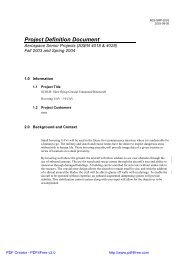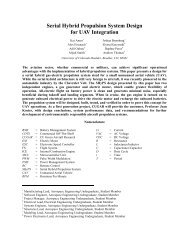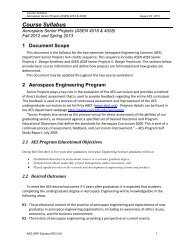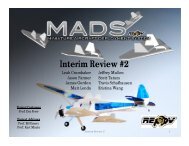PFR - Aerospace Engineering Sciences Senior Design Projects ...
PFR - Aerospace Engineering Sciences Senior Design Projects ...
PFR - Aerospace Engineering Sciences Senior Design Projects ...
Create successful ePaper yourself
Turn your PDF publications into a flip-book with our unique Google optimized e-Paper software.
Project Final Report – CUDBF April 30 th , 2009<br />
ASEN 4028: <strong>Aerospace</strong> <strong>Senior</strong> <strong>Projects</strong><br />
The wing tip displacement was also compared with the COSMOSWorks FEM prediction<br />
together in Figure 120. The measured values are in red asterisks and the FEM predicted<br />
displacement is shown in black line. The model agrees with the measured deflection closely,<br />
especially below a lift load of 30 lbs. The 3g, or 23.5 lbs, predicted deflection of 0.69 inches<br />
agrees exceptionally well with the measured value of 0.71 inches, thus validating the FEM model<br />
of the wing used within COSMOSWorks. The maximum breaking load of the wing was<br />
recorded as 56 lbs, approximately 7.5 g’s; far exceeding the design required 3 g minimum wing<br />
loading. The recorded maximum displacement before failure was 2.25 inches at the wing tip,<br />
and 1.03 inches at the hinge location.<br />
Total Deflection at Tip and Hinge Locations, (in)<br />
2.5<br />
2<br />
1.5<br />
1<br />
0.5<br />
0<br />
Wing Loading Recorded Tip and Hinge Displacements with Error Bars<br />
Wing Tip Deflection (Max = 2.25")<br />
FEM Modeled Wing Tip Deflection<br />
Hinge Point Deflection (Max = 1.03")<br />
-0.5<br />
0 10 20 30 40 50 60<br />
Loaded Weight = Total Lift of Wing Half, (lbs)<br />
Figure 120: Wing Tip and Hinge location Displacement vs. Loading Plot with FEM Model Predicted<br />
Displacement<br />
13.1.4 Avionics Subsystem Verification and Validation<br />
In order to verify that the microcontroller was ready to be used in competition, two tests were<br />
conducted. The first test was to determine if the battery could power the circuit board for the<br />
duration of the missions. The battery was composed of three 1.5V watch batteries soldered<br />
together. A code was programmed to the PIC (Programmable Integrated Circuit) to continuously<br />
run. It was determined that the battery could supply sufficient power for 90 minutes and since<br />
the missions were only ten minutes in duration, the battery was deemed reliable. The second test<br />
was to determine if the microcontroller could receive false signals and release the payloads if the<br />
plane were in flight. The microcontroller was programmed with the complete flight code and the<br />
137
















